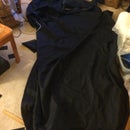Introduction: Motor Mount Box for Radio Control Airplane. I Made It at Techshop
This instructable goes through the process to design and build a motor mount box for mounting outrunner style motors to the front of a radio control airplane. When you build a plane originally designed as a glow engine powered plane you need to figure out how to extend the motor out quite a ways from the firewall. You can use standoffs if you can find those and bolts long enough. You can buy a commercial mount if you can find one that fits the hole pattern on the motor you have. You can make your own. I designed this using Autocad Inventor Professional 2013 and used the Epilog Laser Cutter at Techshop Detroit to cutout the parts.
I made it at Techshop
www.techshop.ws
Step 1: Measure the Spacing and Distance Needed.
In this case I figured out that I needed about 2 inches of space between the plane firewall and the back of the mount. I had previously drilled a set of mounting holes and installed blind nuts to fit the motor mount pattern. I was unable to find over 2 inch 6-32 bolts to use so I couldn't use just a set of standoffs.
Step 2: Draw the Backplate.
I created a back plate drawing. This accommodate 1.625" between the holes and .188 hole diameters. The front and back plate will be 3/16" think and the side parts will all be 1/8". The 3/16" is so that the blind nuts I will be using have a little more substance to sink into.
Step 3: Make a Front Plate.
Create a front plate drawing. Mine uses the same hole pattern front and rear. The inside is drawn so it lines up with the rear surface insides.
Step 4: Create the Sides.
Draw the sides. I put some lightening hole features in to try and keep the weight down. All the parts need to be interlocking. You can draw the sides and then use combine operations to get the notches from one part to go into the other parts.
Step 5: Fix Some Mistakes
When I lasered this out the first time, there wasn't enough material left around the holes. It was very thin and didn't look like it would hold up to the motor torque. I draw an extension around the front and back plate and extruded to make those parts larger.
When I lasered it out after that and glued it together I found out I measured the bolt hole spacing wrong and made it too big to physically fit inside the plane by about an inch. I went back and edited the front and back plate to what it looks like now in the prior steps to the correct size. Fortunately because Inventor is parametric it didn't take too much effort to update it all.
Step 6: Add Some More Side Parts
I was concerned that with the small size of the middle I might need more stiffness so I added a few side parts to it. Those have lightening holes to match the inside parts.
Step 7: Your Finished With the CAD and Cut Out the Parts
At this point the CAD is finished and I went to cutting out the parts. To do the cutting I used 60% speed, 90% power and 500hz on the Epilog 60 watt laser cutter. It requires several passes to cut through but will give good square edges with minimal charing.
Step 8: Glue It All Together
For this step I assembled the parts together and glued them together using West System Epoxy Resin with structural adhesive filler mixed in to make a paste. After gluing it I cleaned it up a bit with some sanding.
Step 9: Mount It to the Plane
I used 1/2" x 6-32 bolts to attach it to the plane with blind nuts I already had installed. I mounted the motor to the front of the box with another set of 1/2" x 6-32 bolts and blind nuts.













